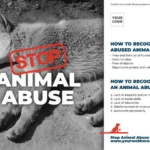Animal cruelty remains a significant concern across the United States, provoking outrage among citizens and prompting legislative action. The legal framework surrounding animal cruelty varies widely from state to state, resulting in a complicated landscape of potential charges and penalties. This article seeks to dissect the legal consequences of animal cruelty, exploring its definitions, types of offenses, and the corresponding jail time that offenders may face.
Understanding Animal Cruelty
The term ‘animal cruelty’ encompasses a wide array of actions directed towards animals, ranging from neglect and abandonment to intentional harm and torture. Generally, the law divides these actions into two primary categories: active cruelty and passive cruelty. Active cruelty entails deliberate actions causing harm or suffering to an animal, such as beating or poisoning. Conversely, passive cruelty typically involves failure to provide necessary care, leading to the animal’s distress or suffering, such as neglecting an animal’s basic needs for food, water, or shelter.
In many jurisdictions, laws are designed to protect animals from both forms of cruelty. However, not all states have equivalent legislation, and the severity of the laws can significantly affect the penalties associated with various offenses.
Classification of Offenses
Animal cruelty laws can also be classified based on the severity of the offense. Generally, states categorize such offenses as either misdemeanors or felonies, and the classification typically hinges on the nature of the act committed. The following outlines the classifications:
- Misdemeanor Charges: Many states categorize certain acts of animal cruelty as misdemeanors, especially cases of neglect or minor incidents of abuse. Common penalties may include fines, community service, and a maximum jail term of up to one year.
- Felony Charges: More egregious acts of animal abuse are often classified as felonies. This classification applies to cases involving severe injury, torture, or death of an animal. Convictions can lead to substantial prison sentences exceeding one year, alongside hefty fines.
Jail Time by Offense Type
Understanding the potential jail time associated with animal cruelty requires an examination of the specific charges brought against the offender. Below is a breakdown of common offenses associated with animal cruelty and the typical legal ramifications:
- Neglect: In many states, neglect is treated as a misdemeanor. Offenders may face up to one year in jail and/or fines. However, repeat offenders may encounter increased severity in penalties, possibly leading to felony charges.
- Physical Abuse: Instances of physical abuse are often categorized as felonies. The jail time for severe abuse can range from one to five years, depending on the jurisdiction. Additional penalties may include restitution to cover veterinary costs and psychological counseling if deemed necessary.
- Animal Fighting: Engaging in or facilitating dog fighting or other organized animal fights is a serious felony offense in most states, often resulting in three to five years of imprisonment. In states with particularly stringent laws, sentences may extend beyond five years, alongside substantial fines and forfeiture of animals.
- Intentional Killing: Deliberately killing an animal can lead to severe penalties, categorized as felonies across the board. Jail time may range from one to ten years, depending on the circumstances and states’ specific laws.
Variations Across States
While the above outlines generally apply to many jurisdictions, it is essential to recognize the significant variations across states. For example, in states like California, animal cruelty is strictly prosecuted under the Penal Code. Here, penalties can reach as high as three years of imprisonment for felony charges. In contrast, states like South Dakota have fewer stringent laws, sometimes resulting in lesser penalties for similar offenses.
Moreover, some states have adopted ‘aggravated’ charges for repeat offenders or heightened offenses, allowing for increased sentencing and harsher penalties. Policymakers are increasingly taking a more robust stance against animal cruelty, which could lead to further variations in the future.
Consequences Beyond Jail Time
In addition to jail time, those convicted of animal cruelty face various collateral consequences that can significantly affect their lives. These may include mandatory psychological evaluations, community service requirements, and prohibitions against owning or caring for animals in the future. Furthermore, many states maintain a public registry of offenders, which can impact employment opportunities and social reputation.
The Role of Advocacy and Legal Reform
Advocacy groups play a crucial role in pushing for stronger animal protection laws. Their efforts have led to increased public awareness of animal cruelty and the consequences for offenders. The growing perception of animal cruelty as a serious crime has motivated many states to re-evaluate and strengthen their legal frameworks, ensuring that those who abuse animals face adequate consequences.
Continued engagement and education regarding the implications of animal cruelty are necessary to foster a culture of empathy and protection for all living beings. The legal breakdown provides insight into the serious implications of animal cruelty offenses and underscores the importance of supporting advocacy efforts aimed at eradicating these heinous acts.
In conclusion, understanding the legal ramifications of animal cruelty is paramount for both individuals and communities. By educating ourselves about the laws and advocating for stronger protections, we can work toward a society that does not tolerate cruelty against animals.








